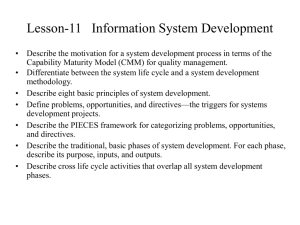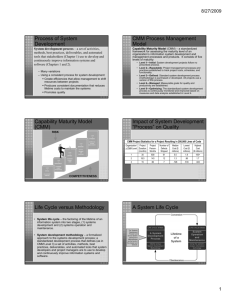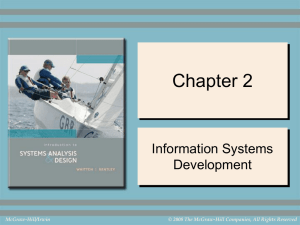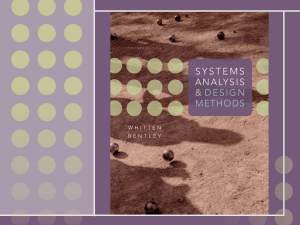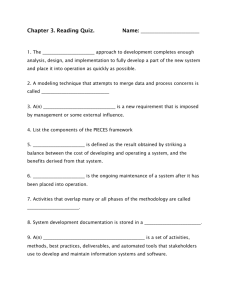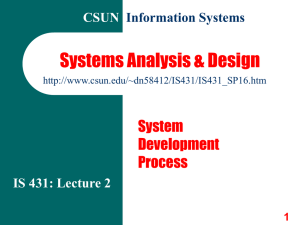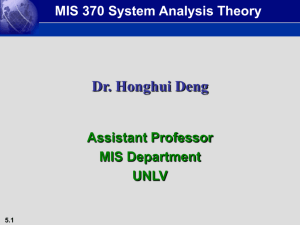System model
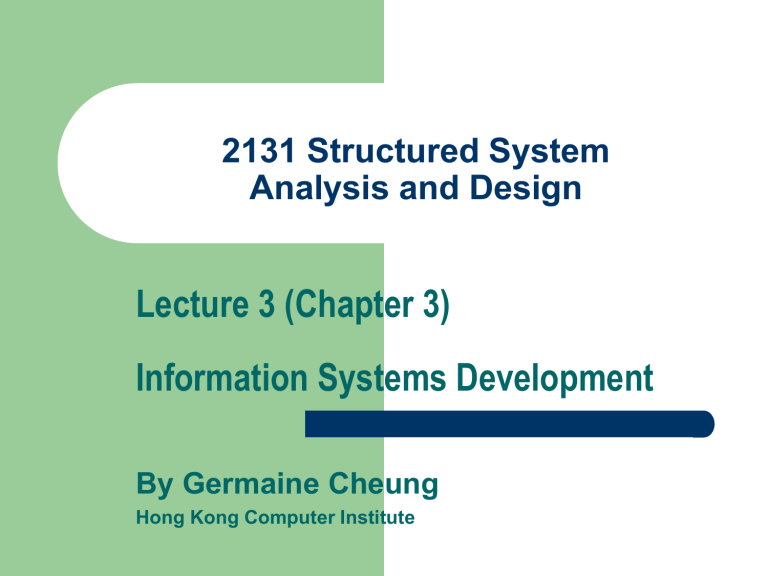
2131 Structured System
Analysis and Design
Lecture 3 (Chapter 3)
Information Systems Development
By Germaine Cheung
Hong Kong Computer Institute
Process of System Development
System development process – a set of activities, methods and best practices that stakeholders use to develop and improve information systems and software.
2
Using a consistent process for system development:
– Create efficiencies that allow management to shift resources between projects
– Produces consistent documentation that reduces lifetime costs to maintain the systems
– Promotes quality
3
The CMM Process Management Model
Capability Maturity Model (CMM) – a standardized framework for assessing the maturity level of an organization’s information system development and management processes and products. It consists of five levels of maturity:
– Level 1 —Initial : System development projects follow no prescribed process.
–
–
–
Level 2 —Repeatable : Project management processes and practices are established to track project costs, schedules, and functionality.
Level 3 —Defined : A standard system development process
(methodology) is purchased or developed. All projects use a version of this process to develop and maintain information systems and software.
Level 4 —Managed : Measurable goals for quality and productivity are established.
– Level 5
—Optimizing
: The standardized system development process is continuously monitored and improved based on measures and data analysis established.
4
Capability Maturity Model (CMM)
5
Impact of System Development
“Process” on Quality
CMM Project Statistics for a Project Resulting in 200,000 Lines of Code
Organization’s
CMM Level
1
2
3
Project
Duration
(months)
30
18.5
15
Project
Person-
Months
600
143
80
Number of
Defects
Shipped
61
12
7
Median
Cost ($ millions)
5.5
1.3
.728
Lowest Cost
($ millions)
1.8
.96
.518
Highest
Cost
($ millions)
100+
1.7
.933
6
Life Cycle versus Methodology
System life cycle – the factoring of the lifetime of an information system into two stages
(1) systems development
(2) systems operation and maintenance
System development methodology – a standardized development process that defines a set of activities that system developers and project managers use to develop and continuously improve information systems and software.
7
A System Life Cycle
Principles of System Development
Get the system users involved
Use a problem-solving approach
Establish phases and activities
Document through development
Establish standards
Manage the process and projects
Justify systems as capital investments
Don’t be afraid to cancel or revise scope
Divide and conquer
Design systems for growth and change
9
Use a Problem-Solving Approach
Classical Problem-solving approach
1.
2.
3.
4.
5.
Study and understand the problem, its context, and its impact.
Define the requirements that must be meet by any solution.
Identify candidate solutions that fulfill the requirements, and select the “best” solution.
Design and/or implement the chosen solution.
Observe and evaluate the solution ’s impact, and refine the solution accordingly.
10
Establish Phases and Activities
Overlap of System Development Phases
11
The Classic Project Phases
12
Manage the Process and Projects
Process management – ensures an organization’s chosen process or management is used consistently on and across all projects. It also defines and improves the chosen process or methodology over time.
Project management is the process of scoping, planning, staffing, organizing, directing, and controlling a project to develop an information system at a minimum cost, within a specified time frame, and with acceptable quality.
13
Justify Information Systems as Capital Investments
Cost-effectiveness – Striking a balance between the costs of developing, maintaining, and operating an information system and the benefits derived from that system. Cost-effectiveness is measured by a cost-benefit analysis.
Strategic information systems plan – a strategic plan for building and improving an information technology infrastructure and the information system applications that use that infrastructure.
Strategic enterprise plan – a strategic plan for an entire business that defines its goals, strategies, benchmarks, and measures of progress and achievement. Usually, the strategic enterprise plan is complemented by strategic business unit plans that define how each business unit will contribute to the enterprise plan.
14
Don’t Be Afraid to Cancel or Revise Scope
Creeping commitment
– a strategy in which feasibility and risks are continuously reevaluated throughout a project. Project budgets and deadlines are adjusted accordingly.
Risk management
– the process of identifying, evaluating, and controlling what might go wrong in a project before it becomes a threat to the successful completion of the project or implementation of the information system.
15
Where Do Systems Development
Projects Come From?
Problem – an undesirable situation that prevents the organization from achieving its purpose.
Opportunity – a chance to improve the organization even in the absence of an identified problem.
Directive - a new requirement that is imposed by management, government, or some external influence.
The PIECES Problem-Solving Framework
(James Wetherbe)
P the need to improve p erformance
I the need to improve i nformation (and data)
E the need to improve e conomics, control costs, or increase profits
C the need to improve c ontrol or security
E the need to improve e fficiency of people and processes
S the need to improve s ervice to customers, suppliers, partners, employees, etc.
17
Where Do Systems Development Projects
Come From?
Planned Projects
– An information systems strategy plan has examined the business as a whole to identify those system development projects that will return the greatest value to the business
– A business process redesign analyzed a series of processes to eliminate redundancy and to improve efficiency and value added.
18
Where Do Systems Development
Projects Come From?
Unplanned projects
– Triggered by a specific problem or opportunity that occurs in the course of doing business.
– Steering committee – system owners and information technology executives that approve candidate system development projects.
– Backlog –proposals that cannot be funded because they are a lower priority than those that have been approved for system development.
19
20
Scope Definition
Problem statement – a statement of problems and opportunities, directives, may also include constraints and an initial vision for the solution.
Constraint – any factor that may limit a solution or the problemsolving process.
Scope creep – a phenomenon wherein the requirements and expectations of a project increase, often without regard to the impact on budget and schedule.
Statement of work – a contract with management and the user community to develop an information system for example defines vision, scope, constraints, high-level user requirements, schedule, and budget, etc.
Logical Design
Logical design – the translation of user requirements into a system model that depicts only the business requirements and not any possible technical design
System model – a picture of a system that represents reality. System models facilitate communication between system users, system analysts, system designers, and system builders.
21
Analysis paralysis – excessive system modeling dramatically slows progress toward implementation of the intended system solution.
22
Decision Analysis
Candidate solutions evaluated in terms of:
– Technical feasibility – Is the solution technically practical?
–
–
–
Operational feasibility – Will the solution fulfill the users’ requirements?
Economic feasibility – Is the solution cost-effective?
Schedule feasibility – Can the solution be designed and implemented within an acceptable time?
– Risk feasibility – What is the probability of a successful implementation using the technology and approach?
23
Physical Design & Integration
Physical design – the translation of user requirements into a system model that depicts a technical implementation of the users’ business requirements.
Two extreme philosophies of physical design
Design by specification – physical system models and detailed specification are produced as a series of written blueprints for construction.
Design by prototyping – Incomplete but functioning applications are constructed and refined based on feedback from users and other designers.
24
System Operation & Maintenance
System support
– the ongoing technical support for users of a system, as well as the maintenance required to deal with any errors.
Cross Life-Cycle Activities
25
Cross life-cycle activity – any activity that overlaps many phases of the systems development process.
–
–
–
–
Fact-finding
using interviews, questionnaires, and other techniques to collect information about system problems.
Documentation and presentation
Documentation –recording specifications for a systems for
current and future reference.
Presentation – recommendations for review by interested users and mangers.
Repository – a database where system developers store all documentation, knowledge for information systems or projects.
Feasibility analysis
Process and project management
Model-Driven Development Strategy
26
Model-driven development –drawing of system models to visualize and analyze problems, define business requirements, and design information systems.
– Process modeling – a process-centered technique popularized by the structured analysis and design methodology that used models of business process requirements to derive effective software designs for a system.
– Data modeling – a data-centered technique used to model business data requirements and design database systems that fulfill those requirements.
– Object modeling – a technique that merge the data and process into singular constructs called objects. Object models are diagrams that document a system in terms of its objects and their interactions.
27
Rapid Application Development Strategy
Rapid application development (RAD) –emphasizes speed of development through extensive user involvement in the rapid construction of series of functioning prototypes of a system that evolves into the final system.
– Prototype –working model of the users’ requirements or a proposed design for an information system.
– Time box – the imposition of a non-extendable period of time, usually 60-90 days, by which the first
(or next) version of a system must be delivered into operation.
28
Commercial Application Package
Implementation Strategy
Commercial Application Package
Implementation Strategy
29
Commercial application package –application purchased and customized to meet the business requirements of a large number of organizations or a specific industry.
–
–
–
Request for proposal (RFP) – a formal document to vendors to compete for the sale of that application package and services.
Request for quotation (RFQ) – a formal document to a single vendor that has been determined as being able to supply that application package and services.
Gap analysis – a comparison of business and technical requirements for a commercial application package against the features of a specific commercial application package for defining the requirements that cannot be met.
30
A System Maintenance Perspective
31
Computer-Assisted Software Engineering
(CASE)
Computer-aided systems engineering (CASE) – the use of automated software tools that support the drawing and analysis of system models and associated specifications.
Some CASE tools also provide prototyping and code generation capabilities.
– CASE repository – a system developers’ database where developers can store system models, detailed descriptions and specifications.
–
–
Forward engineering – a CASE tool capability that can generate initial software or database code directly from system.
Reverse engineering – a CASE tool capability that can generate initial system models from software or database code.
32
Application Development Environments
Application development environments (ADEs) – an integrated software development tool that provides all the facilities necessary to develop new application software with maximum speed and quality.
ADE facilities may include:
Programming languages or interpreters
Interface construction tools
Middleware
Testing tools
Version control tools
Help authoring tools
Repository links
33
Process and Project Managers
Process manager application – an automated tool that helps document and manage a methodology and routes, its deliverables, and quality management standards.
Project manager application – an automated tool to help plan system development activities, estimate and assign resources, schedule activities and resources, monitor and control schedule and budget, and report project progress.
